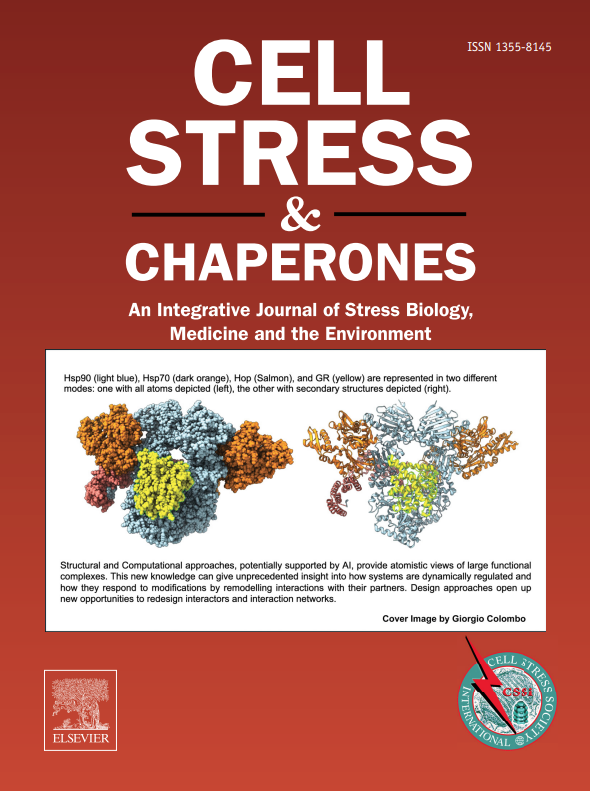热诱导的磷脂酰丝氨酸改变驱动HSPA1A的质膜定位。
IF 3.2
3区 生物学
Q3 CELL BIOLOGY
引用次数: 0
摘要
HSPA1A是细胞存活中至关重要的分子伴侣。除了胞质功能外,HSPA1A还易位到热休克细胞和癌细胞的质膜(PM)。在癌症中,pm定位的HSPA1A (mHSPA1A)与肿瘤侵袭性和治疗耐药性增加有关,这表明阻止其膜定位可能具有治疗价值。这种易位取决于HSPA1A与PM磷脂的相互作用,包括磷脂酰丝氨酸(PS)。虽然PS结合调节HSPA1A的膜定位,但这种运动的确切触发因素尚不清楚。鉴于脂质修饰是癌症的标志,我们假设PS是驱动HSPA1A易位的关键脂质,热诱导的PS水平变化触发HSPA1A在热应激下的PM定位。我们使用药物抑制和RNA干扰(RNAi)靶向PS合成,结合共聚焦显微镜,脂质组学和western blotting验证了这一假设。脂质组学分析和PS特异性生物传感器证实了热休克诱导的PS增加,在应激后立即达到峰值。用苯苯胺和RNAi抑制PS合成可显著降低HSPA1A的PM定位,而胆固醇或脂肪酸的消耗对PS的影响最小,证实了PS的特异性。进一步的实验表明,PS饱和度和延伸率的变化对HSPA1A的PM定位没有显著影响,这表明PS总量的增加,而不是特定的PS种类,是关键因素。这些发现重塑了目前的HSPA1A转运模型,表明PS是热休克反应中HSPA1A膜易位的关键调节因子。这项工作为脂质调节蛋白运输提供了新的见解,并强调了PS在控制细胞应激反应中的重要性。本文章由计算机程序翻译,如有差异,请以英文原文为准。
Heat-induced phosphatidylserine changes drive HSPA1A's plasma membrane localization
HSPA1A is a molecular chaperone crucial in cell survival. In addition to its cytosolic functions, HSPA1A translocates to heat-shocked and cancer cells' plasma membrane (PM). In cancer, PM-localized HSPA1A (mHSPA1A) is associated with increased tumor aggressiveness and therapeutic resistance, suggesting that preventing its membrane localization could have therapeutic value. This translocation depends on HSPA1A's interaction with PM phospholipids, including phosphatidylserine (PS). Although PS binding regulates HSPA1A's membrane localization, the exact trigger for this movement remains unclear. Given that lipid modifications are a cancer hallmark, we hypothesized that PS is a crucial lipid driving HSPA1A translocation and that heat-induced changes in PS levels trigger HSPA1A's PM localization in response to heat stress. We tested this hypothesis using pharmacological inhibition and RNA interference targeting PS synthesis, combined with confocal microscopy, lipidomics, and western blotting. Lipidomic analysis and PS-specific biosensors confirmed a heat shock-induced PS increase, peaking immediately post-stress. Inhibition of PS synthesis with fendiline and RNA interference significantly reduced HSPA1A's PM localization, while depletion of cholesterol or fatty acids had minimal effects, confirming specificity for PS. Further experiments showed that PS saturation and elongation changes did not significantly impact HSPA1A's PM localization, indicating that the total PS increase, rather than specific PS species, is the critical factor. These findings reshape current models of HSPA1A trafficking, demonstrating that PS is a crucial regulator of HSPA1A's membrane translocation during the heat shock response. This work offers new insights into lipid-regulated protein trafficking and highlights the importance of PS in controlling cellular responses to stress.
求助全文
通过发布文献求助,成功后即可免费获取论文全文。
去求助
来源期刊

Cell Stress & Chaperones
生物-细胞生物学
CiteScore
7.60
自引率
2.60%
发文量
59
审稿时长
6-12 weeks
期刊介绍:
Cell Stress and Chaperones is an integrative journal that bridges the gap between laboratory model systems and natural populations. The journal captures the eclectic spirit of the cellular stress response field in a single, concentrated source of current information. Major emphasis is placed on the effects of climate change on individual species in the natural environment and their capacity to adapt. This emphasis expands our focus on stress biology and medicine by linking climate change effects to research on cellular stress responses of animals, micro-organisms and plants.
 求助内容:
求助内容: 应助结果提醒方式:
应助结果提醒方式:


